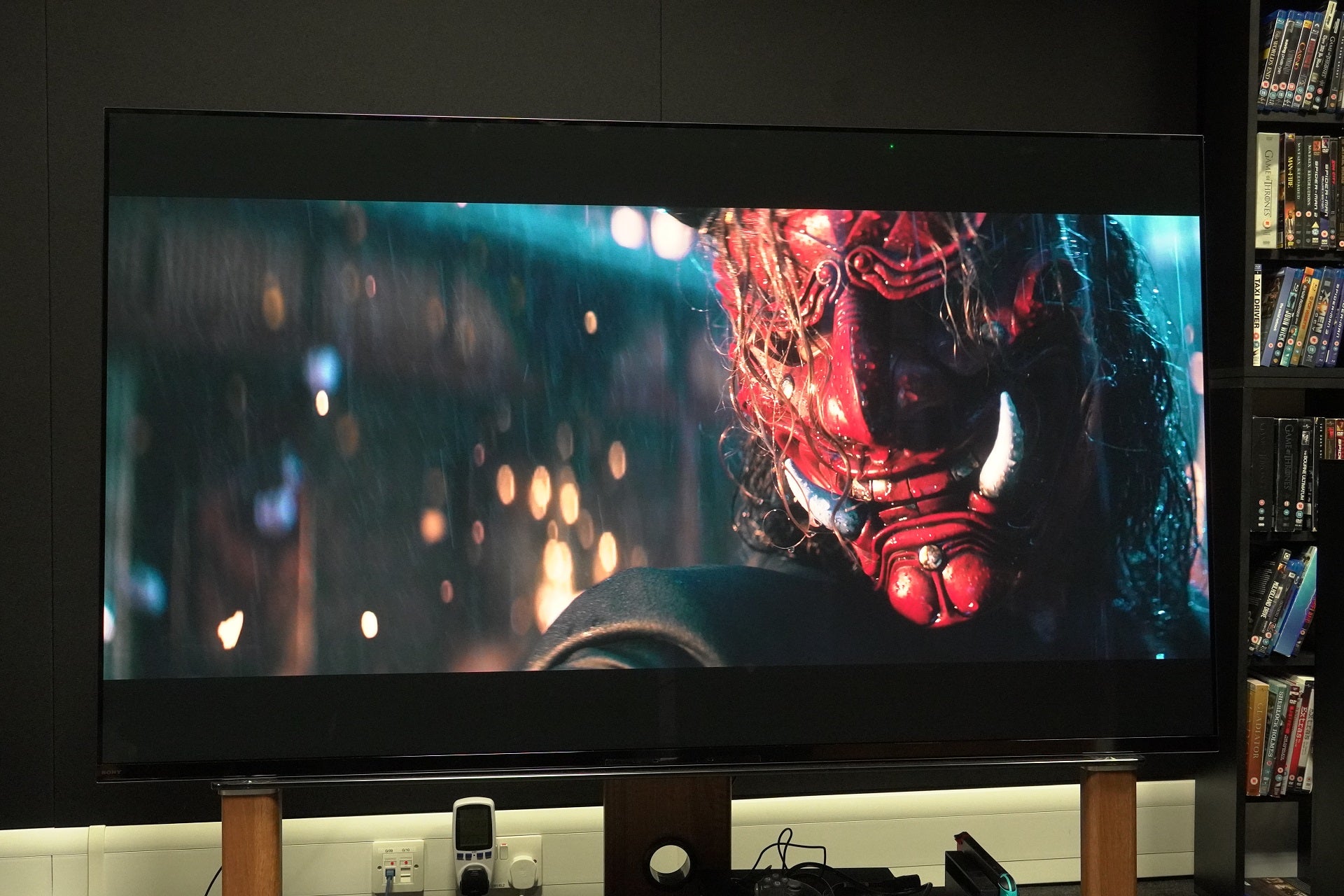Verdict
The Sony A95K – the brand’s first QD-OLED TV – is undoubtedly impressive from a picture and audio perspective. It’s not perfect as the design could be more accommodating, and its feature-set doesn’t have the wide appeal of its rivals, but if you love watching TV and film on a giant screen, this Sony serves up a frequently gorgeous image.
Pros
- Gorgeous Dolby Vision image
- Slick motion handling
- Expansive sound system
- Good upscaling (up to a point)
- Accessible smart interface
Cons
- Obstructive stand
- Red push to complexions
- Still expensive
Availability
- UKTBC
- USATBC
- EuropeTBC
- CanadaTBC
- AustraliaTBC
Key Features
-
QD-OLED screenQuantum Dot panel supplied by Samsung Display -
VRR supportVariable refresh rates support for gaming -
Cognitive Processor XRImproves colour contrast and depth perception in an image
Introduction
When QD-OLED was first announced by Samsung Display, I didn’t expect another TV brand would hog the limelight by being the first to reveal the new tech.
But that’s exactly what Sony did, gazumping Samsung with the A95K, a TV that merges the best characteristics of Quantum Dot technology – high brightness and wide colour range – with the perfect blacks and contrast of OLED.
This first-gen model will eventually be usurped by the A95L in the second half of 2023. Should you hold off or get the A95K? Read on to find out.
Design
- Imposing presence
- Minimalist aesthetic
- Dual-stand positioning
This first-gen QD-OLED is available in two sizes: the 65-inch version (XR-65A95K), and the 55-inch form (XR-55A95K) we reviewed in 2022.
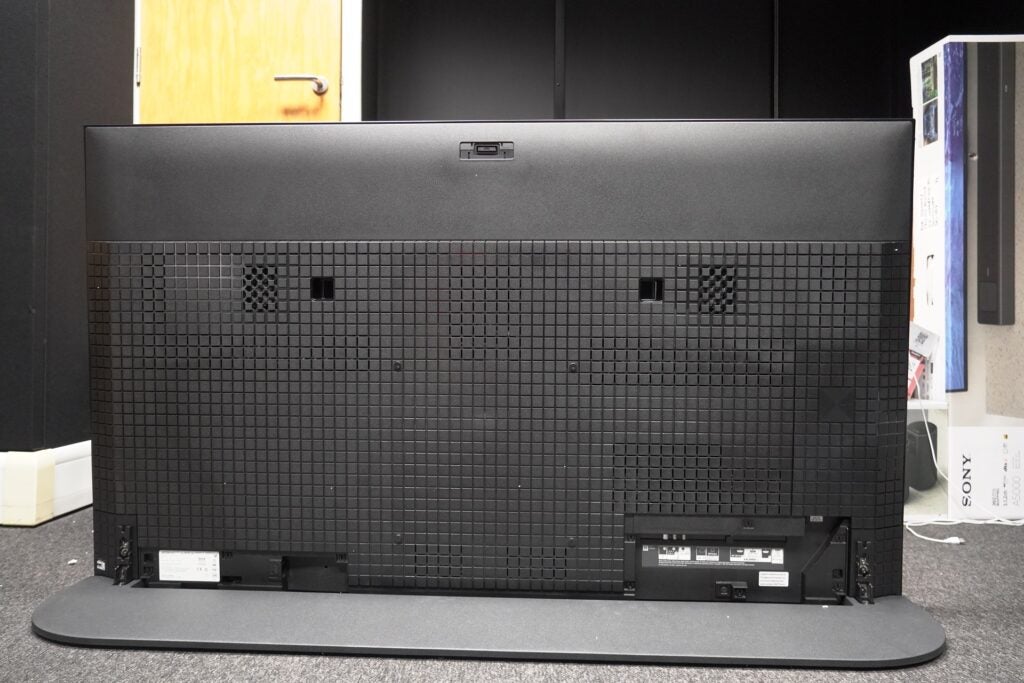
As befitting its 65-inch screen, the Sony A95K is sizable piece of TV real estate but in-keeping with Sony’s design philosophy, it’s also minimalist in appearance. The bezel on the top and sides is barely noticeable, which gives the screen an opportunity to dominate.
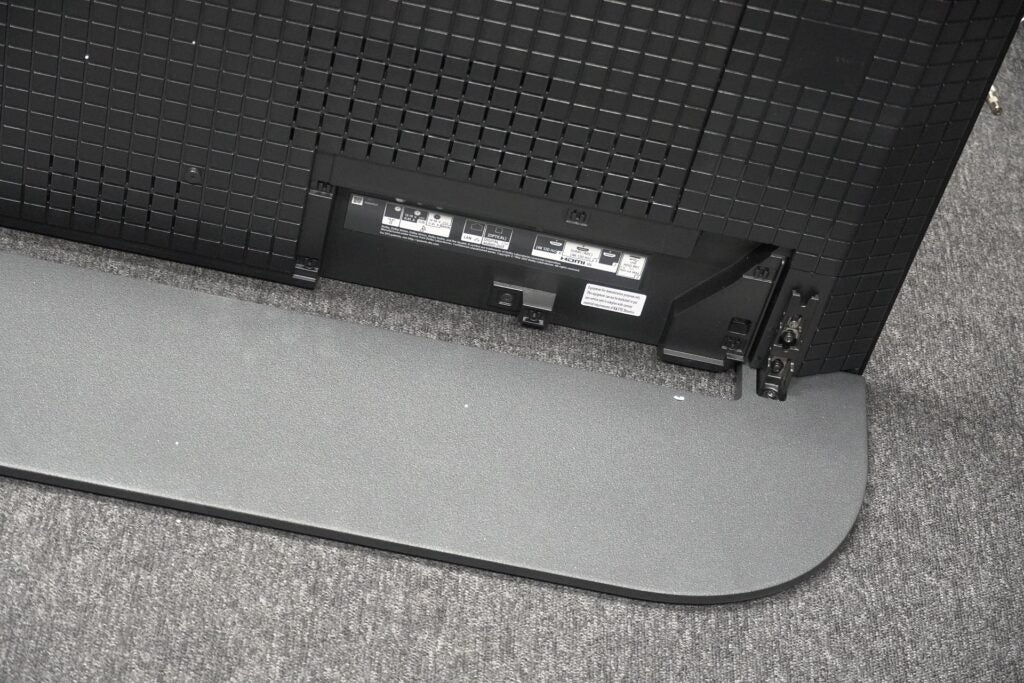
The Sony A95K comes with a stand, which can be positioned in two ways: front and back.
The idea is if you want it sat close to a wall, place the stand on the front in the ‘wall fit’ position. Place it behind and it acts as a counterweight with a lean of around three degrees in similar fashion to the A1 OLED. Whichever option you go for, the stand requires plenty of space. Even on a stand for 65-inch TVs, it’s hanging over both edges.
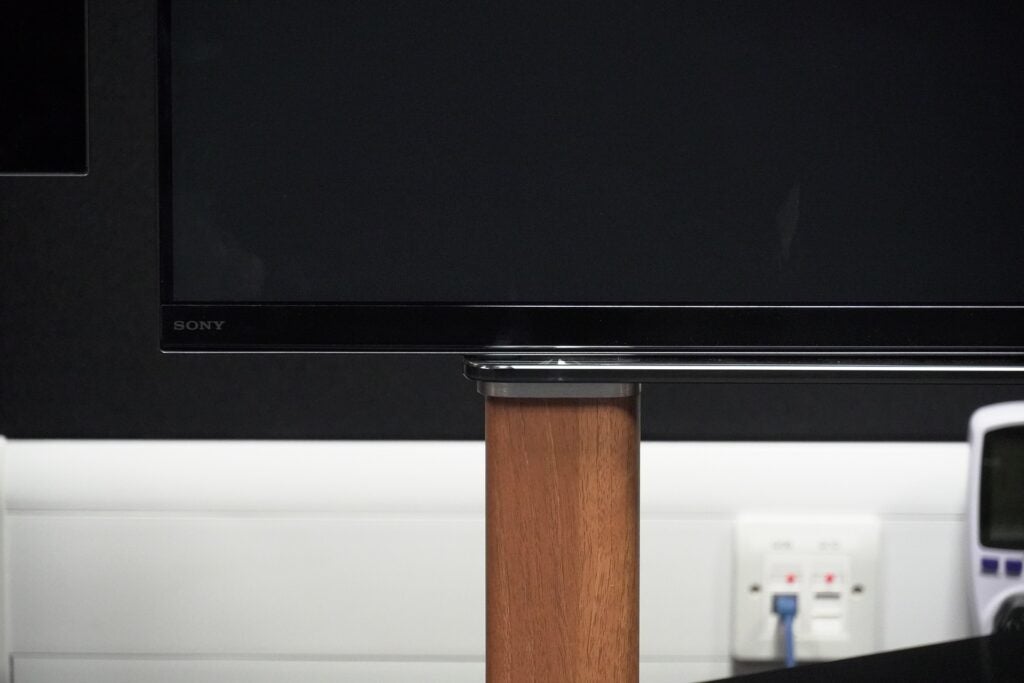
Connections are downward-facing, and positioned towards the bottom of the TV’s rear end, and with the stand attached that makes connecting sources a pain to slot in. I also have no idea where the HDMI 1 input is – I’ve been staring at the back of this TV for weeks and I cannot for the life of me figure out where it is.
Google TV Interface
- Better curation than Android TV
- Watchlist still in the wrong place
- Premium remote
Sony moved to the Google TV interface a few years back, and I find it an improvement over Android TV. The interface is cleaner, more colourful, and visually more interesting which has the added effect of making it more inviting to use.
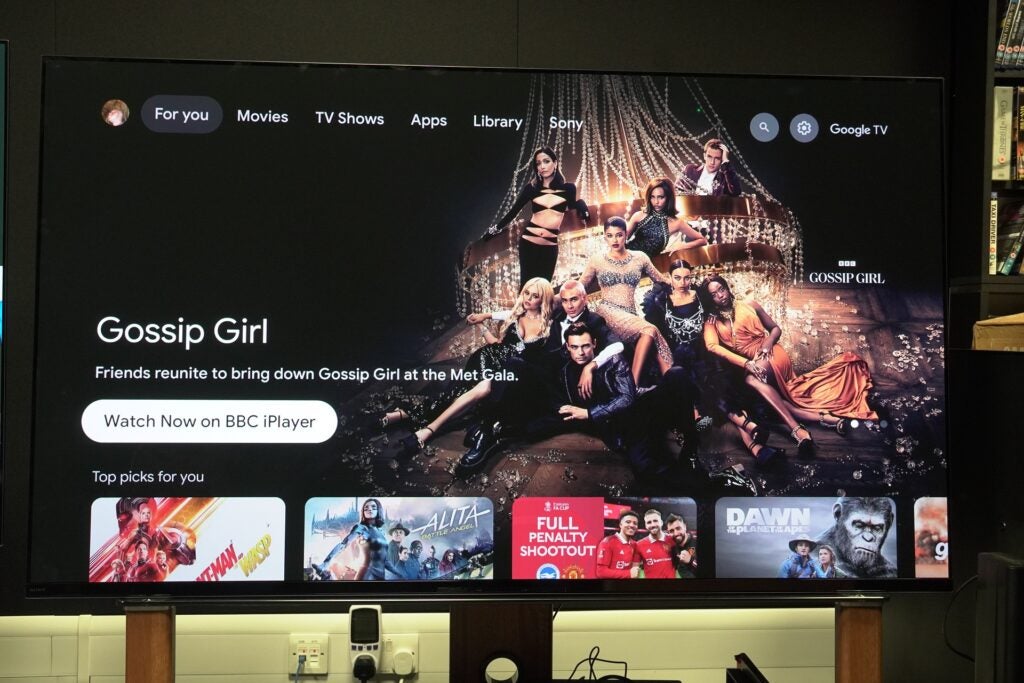
I still think not having the Watchlist on the Home page is a mistake. I get the point of furnishing users with more ‘new’ curated content, but I also think it’s daft that saved content is squirrelled away in the ‘Library’ tab instead of being on the ‘Home’ page. I want my content – new and old – close by, and this doesn’t do that.
There are tabs for Movies, TV, Apps, Library, and Sony; the latter is for services such as BRAVIA Core where you can stream Sony titles at near 4K Blu-ray bitrates (if you have the connection speeds for it). Landing pages for titles in ‘Movies’ and ‘TV’ are the same as they are on Android, aside from the ‘thumbs up/down’ button that feeds into the all-conquering algorithm to serve up more titles to watch.
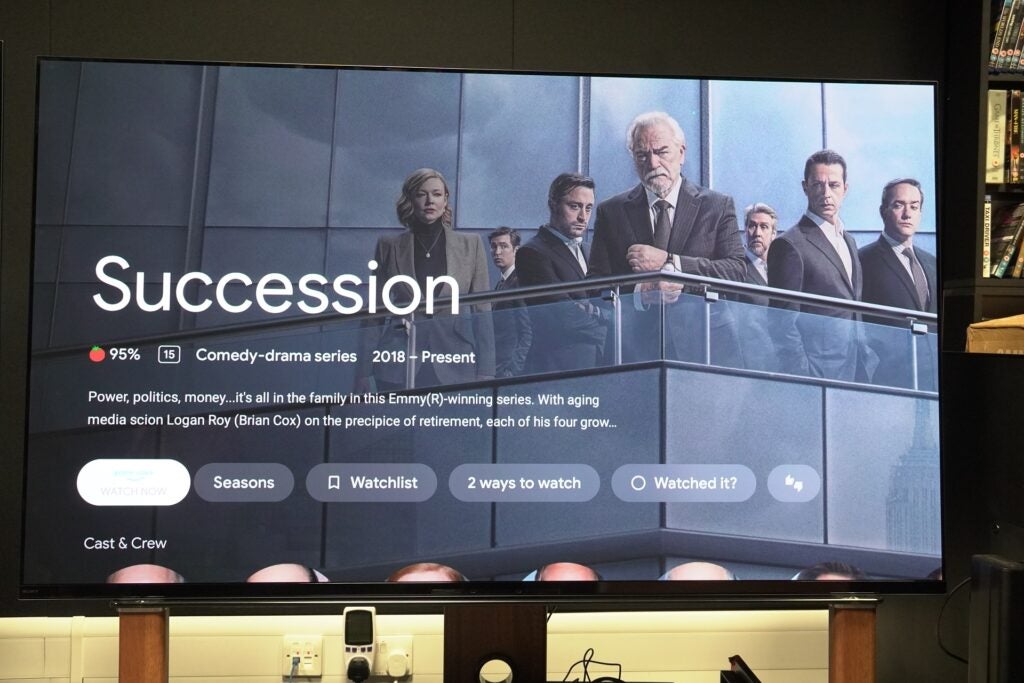
Towards the right-hand side of the screen are quick settings where you can access inputs, picture settings, notifications, and your Google profile. Hit the settings button on the remote and that brings up a quick setting menu for more customisation. Having both seems rather a little too much.
From there you can head to the main settings section, though one aspect that annoys me is that if you’re streaming a programme, it kicks you out from the app and returns you to the ‘Home’ screen. WebOS and Tizen don’t do that.
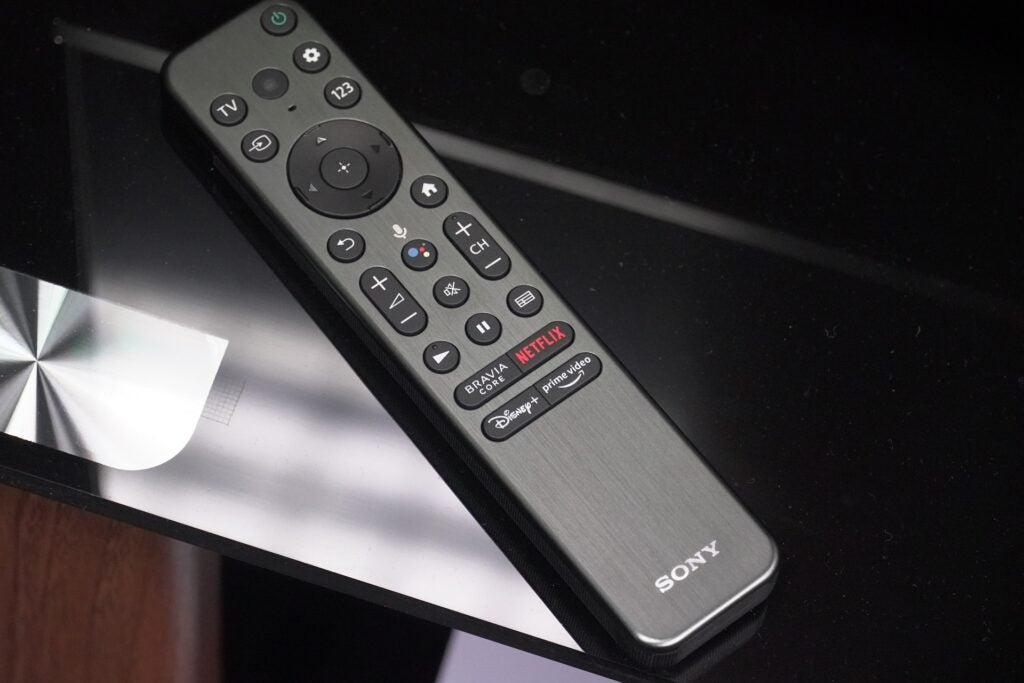
The remote has an aluminium sheen and backlit buttons. It’s slimmed and reduced in size from the already elegant wand of previous years, with fewer buttons and a sparser look, as well as quick access buttons to BRAVIA Core, Netflix, Prime Video and Disney+.
If you lose the remote, you’ll be glad to know it has a finder function. You can ask the TV (through its built-in microphones) ‘where’s my remote?’ and it’ll play a tune to help locate it.
Features
- Comes with the new BRAVIA CAM
- HDMI 2.1 includes VRR and 4K/120Hz
- New Netflix Adaptive Calibrated mode
The Sony A95K has the BRAVIA CAM as standard that can be put on top in the centre via a connector round the back. This camera can recognise where people are sitting in a room and optimise picture and sound accordingly (through the Ambient Optimisation Pro feature). There’s support for gesture controls and video chat.
Alongside BRAVIA Core there’s Netflix Adaptive Calibrated mode that uses the A95K’s built-in light sensor to tweak contrast and detail in accordance with a room’s ambient light for optimal picture performance. There’s no Filmmaker mode (Sony trusts its own processing) although there is a Creator Calibrated Mode for BRAVIA Core and Netflix that allows the user to adjust and optimise settings.
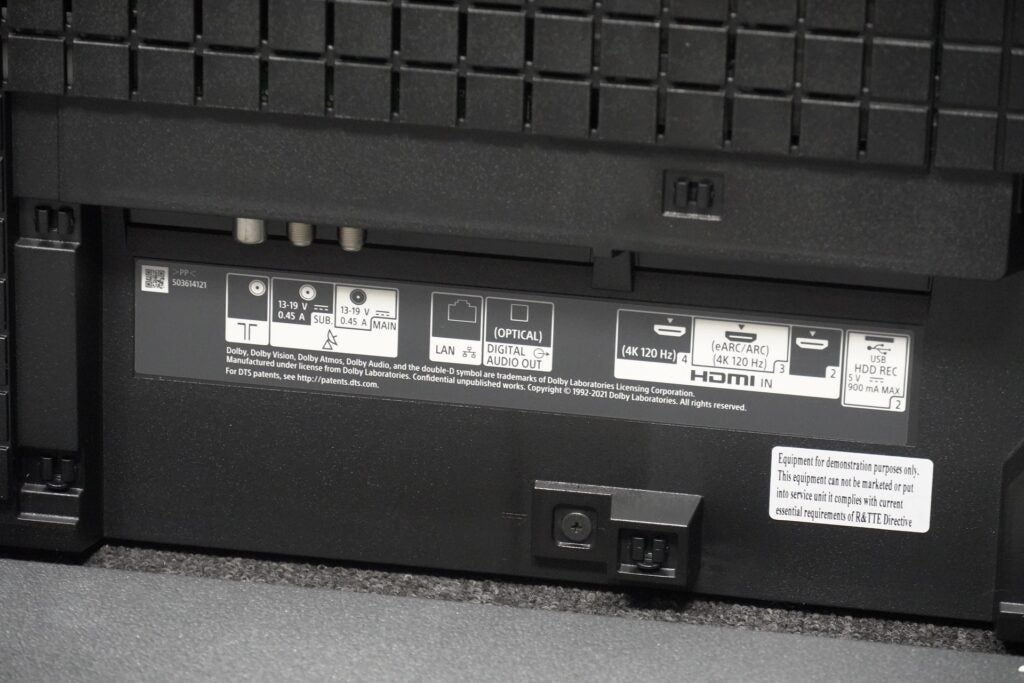
The A95K has two HDMI 2.1 inputs and supports variable refresh rates (VRR), auto low latency mode (ALLM) and 4K/120Hz. Latency is claimed to be around 8.5ms, but my measurements showed it at 16.1ms. My assumption is the 8.5ms figure is with VRR enabled.
PS5 owners benefit from Auto Genre Picture mode (basically ALLM) and Auto HDR Tone Mapping that optimises the PS5’s HDR output to the Sony TV it’s connected to. This feature is very good out of the box with few adjustments needed to get the right HDR performance. Although you could play games in Dolby Vision, there’s not a native Dolby Vision game mode. That’ll be supported by the A95L.
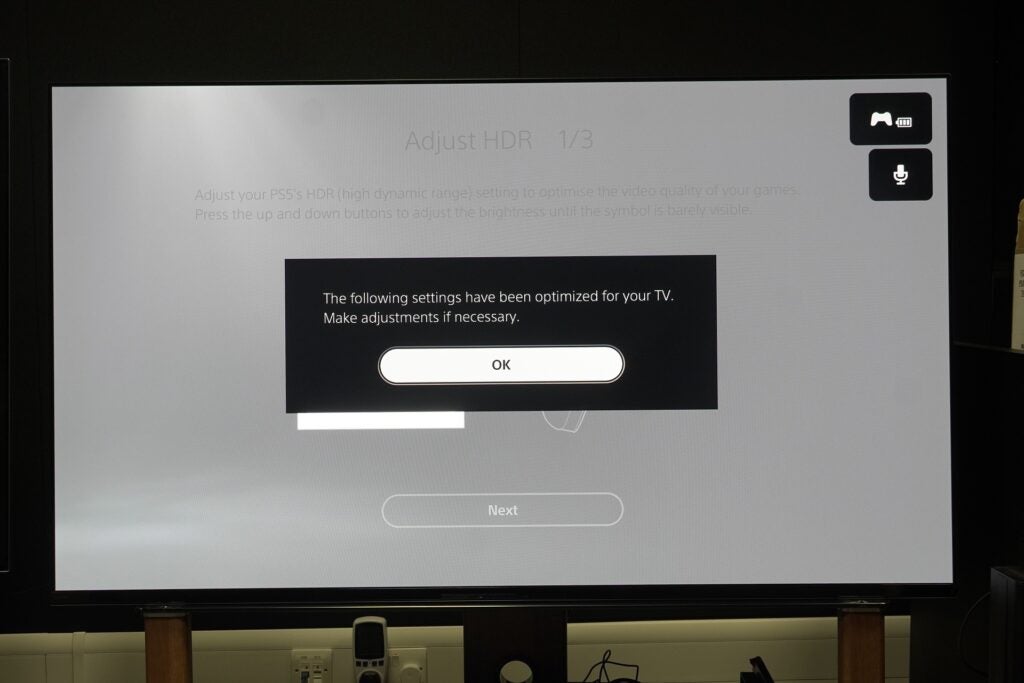
The rest of the features includes Chromecast and Google Assistant: AirPlay 2 and HomeKit, ‘works with’ Alexa support (via another compatible device) and Bluetooth connectivity. Physical connections include a terrestrial and (two) satellite inputs, Hybrid with S-Center Speaker Input, digital audio output, Ethernet and two USB inputs.
QD-OLED is still susceptible to screen burn, but the A95K features a diffusion sheet to distribute heat uniformly to prevent image retention.
Picture Quality
- More natural looking colours and gradations
- Impressive motion
- Strong upscaling up to a point
A lot has been made about the brightness of QD-OLED vs OLED, and it’s true the Sony A95K doesn’t blitz the competition in terms of HDR peak brightness. The Samsung S95B is marginally brighter, indeed the 2022 LG G2 OLED is brighter while the G3 OLED blows it out of the water.
I measured the Sony at 980 nits on a 5% HDR window (Cinema mode brought up similar results), while Vivid mode crept above 1000 nits. It shows the Sony isn’t looking to dazzle with its peak brightness, and while brightness isn’t the be-all and end-all, the combination of its brightness and the colour performance of QD-OLED panel is a potent one for the Sony A95K.
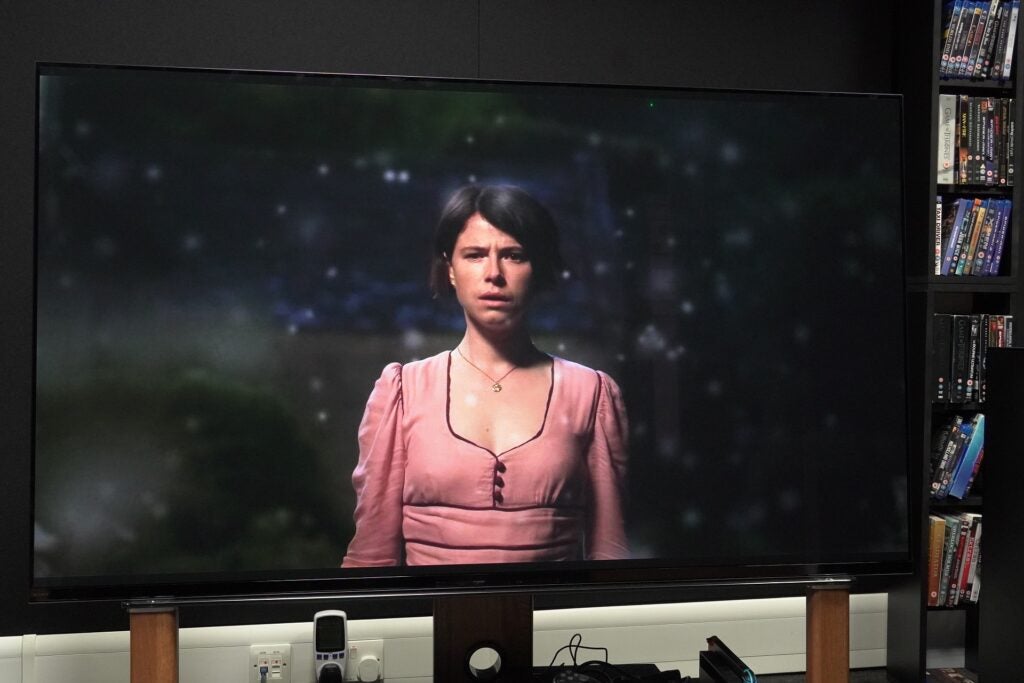
There are issues, however. The Sony A95K (like the Samsung S95B) suffers from a red push. Complexions of characters in a Prime Video stream of Men err towards the red spectrum, which can make them look overly done – the pink colour of the dress Jessie Buckley’s character wears has more punch than it does an LG OLED65G3, but I feel the LG strikes a more natural look.
Another slight issue are black levels. The A95K struggles in low-light scenes, the kind of which are frequent in Netflix’s The Dig. A scene in a pub is conveyed in a vague, murky manner, with blacks appearing raised rather than true black. The resulting image is one with a fuzzy sense of definition.
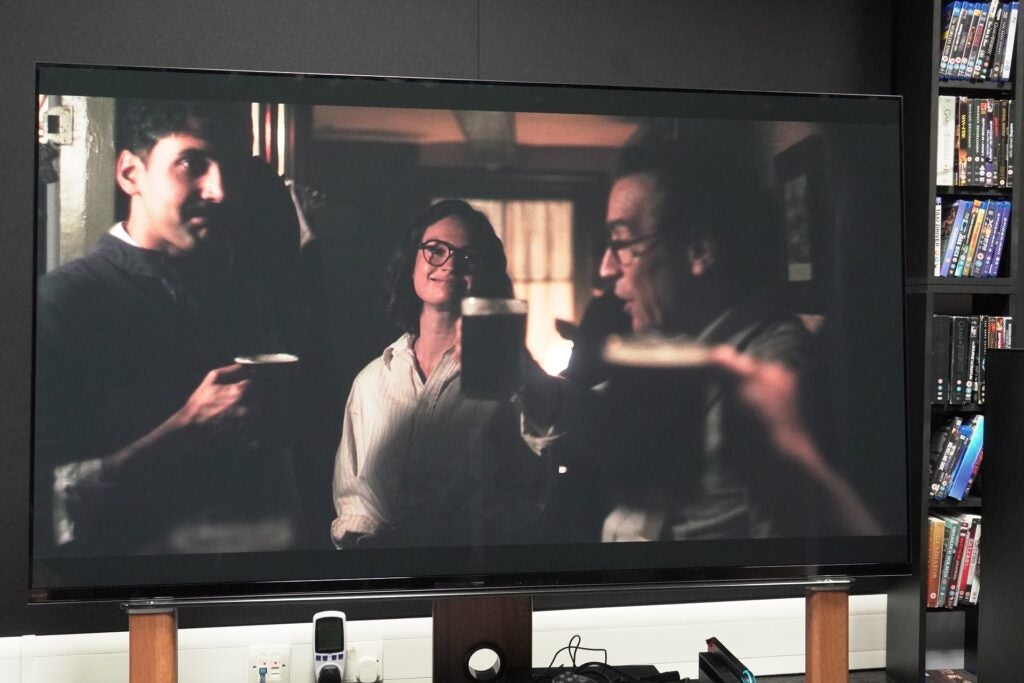
The A95K’s Cognitive XR processor doesn’t quite extract every bit of detail from people’s faces either. It’s a small detail but creases and wrinkles on people’s foreheads are smoothed out – once you notice it, it gives faces a waxier look.
Now onto the good stuff. Colours are wide-ranging and varied. Compared to an LG G3 OLED there are more shades of colours in any given image, and the Sony tends to pick out small colour details – the slight gold tinge in Edith Pretty’s hat in The Dig – that slips by LG.

With the right film, the set’s Dolby Vision performance is strikingly good. Bullet Train looks sumptuous with super levels of contrast that create a three-dimensional sense of depth to the image. Colours within the carriages vary from luxuriant and rich to great-looking neon tones, and complexions appear more naturally handled with the aid of Dolby’s HDR format. Sharpness, detail, and clarity are all high – this is an immersive viewing experience.
Whites are also purer and cleaner in tone, taking on a brilliant look that would have Daz cleaning powder looking on with envy. Although there is the red push, complexions look stronger and brighter, and the A95K uses its brightness to good effect with highlights – Captain Marvel’s pulse blasts beam with more intensity on the Sony.
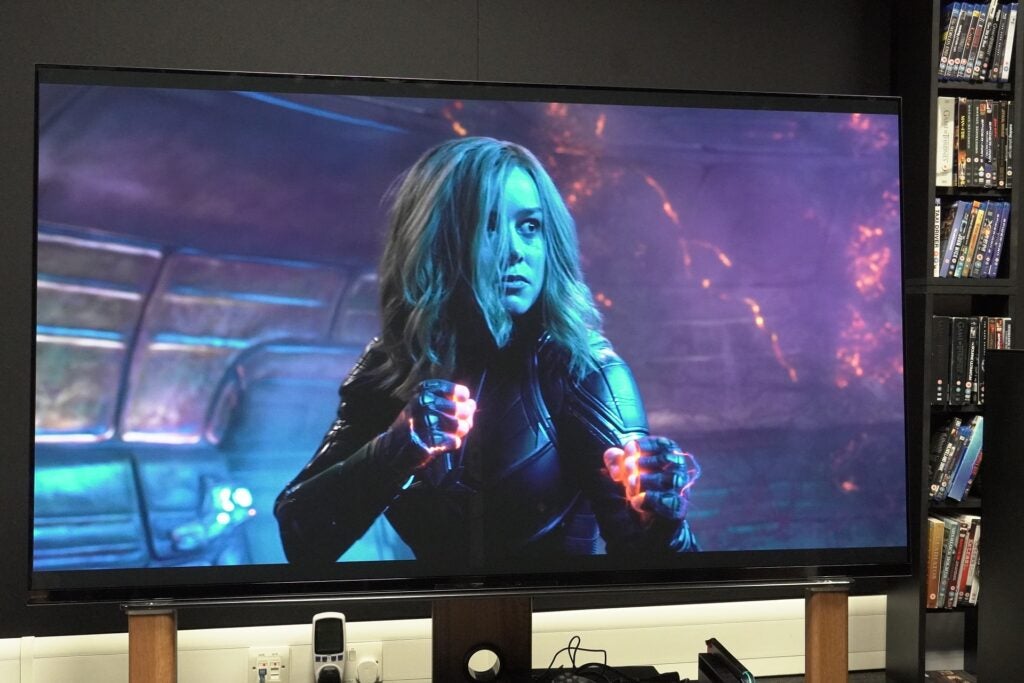
Although its black levels aren’t as strong, conversely the Sony’s sense of near-dark detail is better than the LG G3, picking out more detail in darker scenes. Slightly waxy foreheads aside, overall detail levels impress as the Sony can pick out small details with finesse.
Sony’s motion interpolation is one of the best in the TV market and is very good on the A95K. With a 4K Blu-ray of 1917 on screen it retains the filmic, 24fps look of film without causing the Soap Opera Effect. The image is stable, there’s less noticeable blur as Schofield stumbles through the trenches, although there is minor judder to his hand movements and edge noise around his jacket.
It’s never too distracting though and avoids artificiality or cardboard sense of depth. There are times when motion is better on LG’s OLEDs, especially with panning shots which on the LG are more stable. I’d recommend avoiding the ‘Clearness’ setting that inserts a black frame as it creates a flickering effect like a fluorescent light.
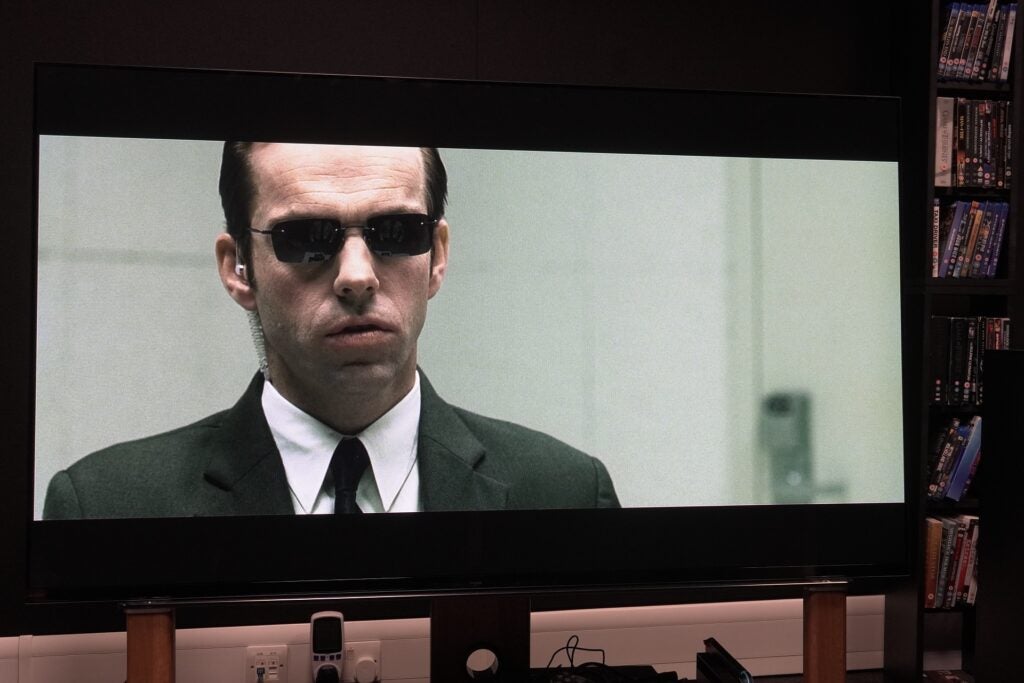
Upscaling of Hi-Def and standard definition sources is not as sharp as Samsung and LG’s models, but that appears intentional. A Blu-ray of The Matrix didn’t boast the same levels of clarity and sharpness I’ve seen on 2023 OLEDs, but still came across as detailed and defined. The inherent film grain wasn’t treated as noise, looking more filmic and soft.
Streaming Men in HD brought smoother gradation with colours in the intense flashback scenes. There’s more noise and striping visible in the corners of the image on the LG G3, while with the A95K the various red and orange hues blend more seamlessly.
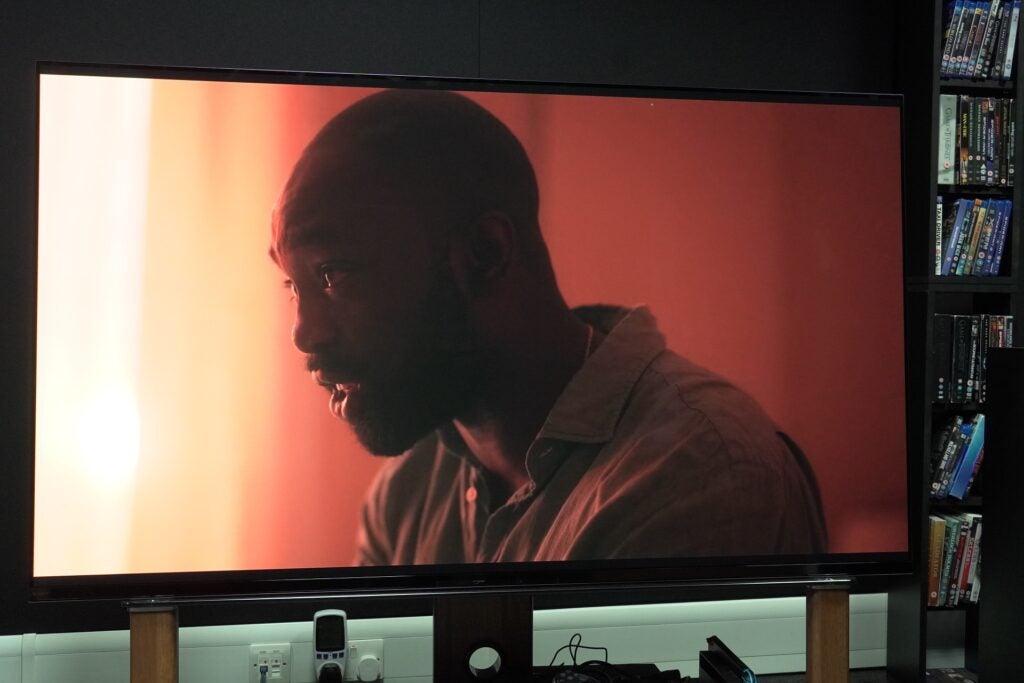
With standard definition, it’s more of a struggle. Colours are conveyed naturally, there’s no obvious striping and gradations look smooth enough, but there is signal noise that the Sony A95K can’t smooth out, whether it’s in people’s faces or around them. Edges are soft, textures are smoothed over – a DVD of Bad Boys or Star Trek sees the LG G3 OLED manage noise better than the A95K.
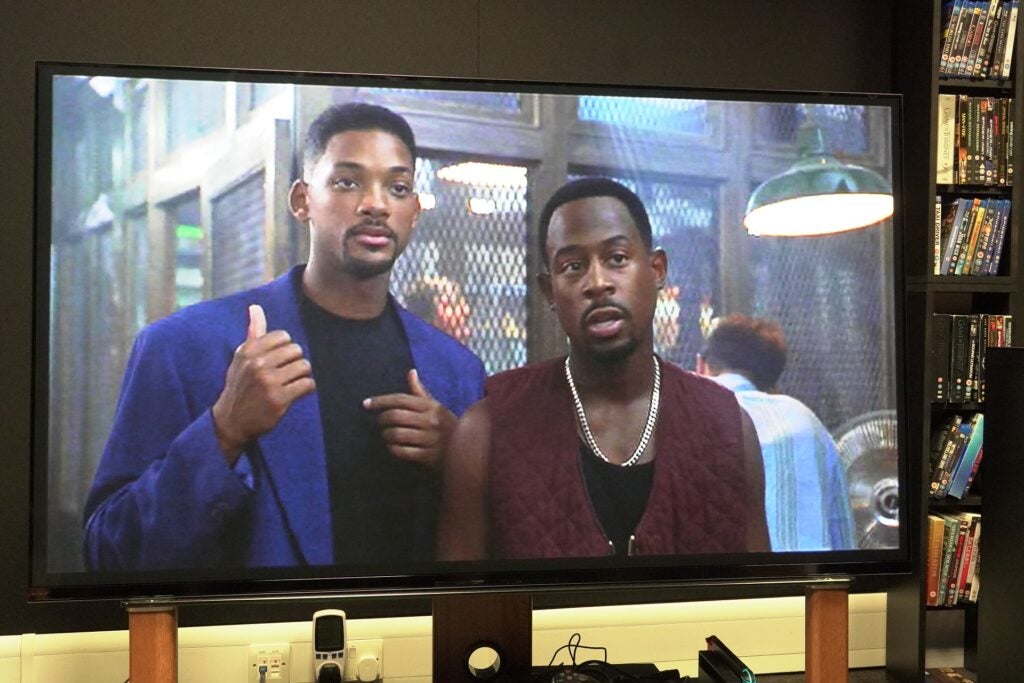
Sound Quality
- Features actuators that vibrant the screen
- Punchy, weighty bass
The XR-65A95K uses Sony’s Acoustic Surface Audio+, which vibrates the screen to produce sound. Made up of two large actuators and two subwoofers, the actuators produce surprising amounts of power, detail, and clarity.
This is a punchy, expansive, and clear-sounding performance from a TV system. There’s punch to the low end and more weight than from any LG or Samsung TV I’ve heard in the past few years.
Voices tend to emanate from where they’re located on screen, and dialogue is clean, crisp, and weighty. They’re also just conveyed at a louder level than I’ve heard from other TVs. You won’t struggle to hear what’s said on the A95K.
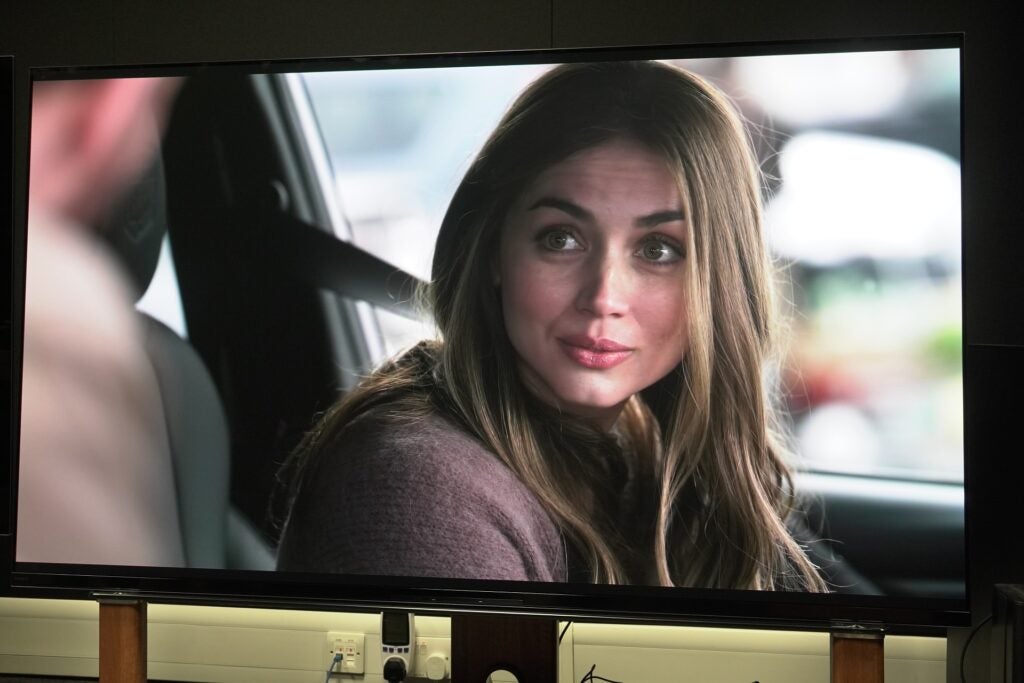
Watching Ghosted on Apple TV+ where Cole and Sadie meet for the first time, and compared to the LG G3 OLED, the Sony picks and clarifies out the surrounding ambience of the market with more detail; action scenes are elevated by higher levels of dynamism and loudness, and the A95K can project sounds from its screen better than the G3 OLED.
It did, after a while, develop an issue with treble when streaming Men, sounding overly sharp and distorted. I’m not sure why, but it comes and goes as it pleases.
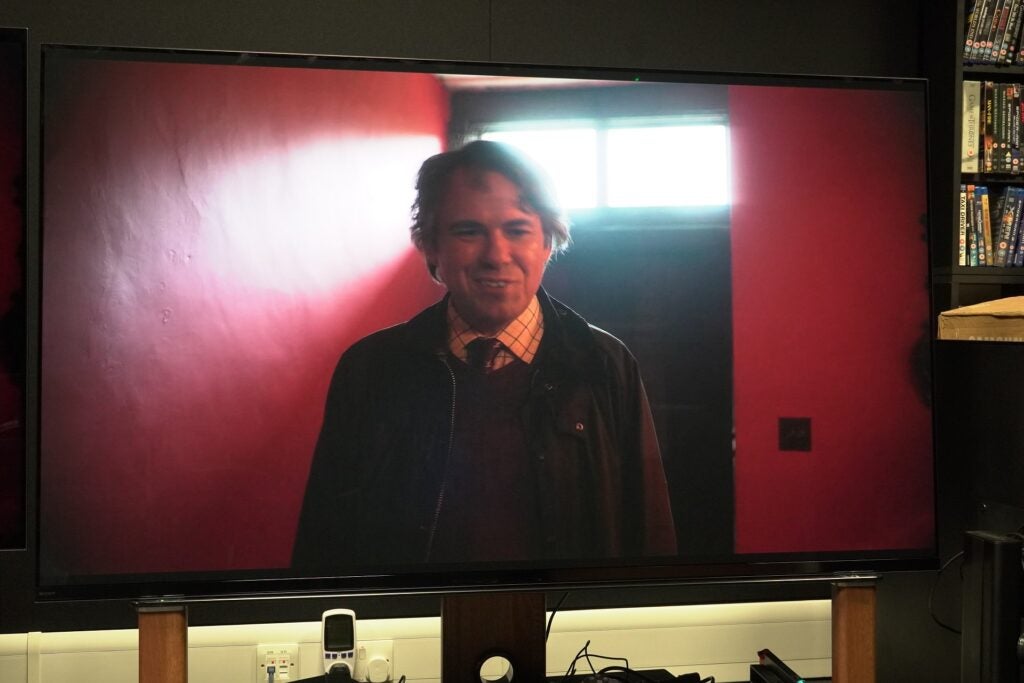
Describing the height (there’s no real upward firing aspect to this sound system) and depth of the soundstage is an area the Sony A95K can struggle with. It does it better than other TVs in conveying quiet/loud and near/far, but this is a flatscreen TV and there are limits. Those limits are, however, above most other premium TVs.
Latest deals
Should you buy it?
If you want sensational looking images: This Sony serves up a striking image with Dolby Vision content. Of the first-gen QD-OLEDs, it’s the better model from a picture and audio standpoint.
You want a less cumbersome design: The Sony A95K’s stand takes up too much space and doesn’t allow space for a soundbar. In short, it’s irritating to deal with.
Final Thoughts
From its gorgeous Dolby Vision image to its audio performance, the Sony A95K is a high performing OLED TV.
It’s still mightily expensive at £2999 almost a year after its release, priced similarly to new models such as the LG OLED65C3 and Samsung QE65S90C.
Black levels and a slight red push do affect picture quality. It’s not built for gamers unless you own a PS5, and even then, the features aren’t the most wide-ranging.
Sony asks a high price for the A95K, and for cinema and TV fans it’s worth paying. It sets a very good foundation for A95L, which can hopefully take things to even higher levels.
How we test
We test every television we review thoroughly over an extended period of time. We use industry standard tests to compare features properly. We’ll always tell you what we find. We never, ever, accept money to review a product.
Find out more about how we test in our ethics policy.
Tested over several months
Tested with real world use
Benchmarked with Spears & Munsil disc
FAQs
You could play supported games in Dolby Vision on the A95K, but only up to 60Hz and not 120Hz.
Jargon buster
QD-OLED
QD-OLED or Quantum Dot display is an emissive display that combines Quantum Dot colour technology and OLED-like contrast, viewing angles and perfect blacks. QD-OLED can also hit brighter overall and peak levels for HDR content
Verdict
The Sony A95K – the brand’s first QD-OLED TV – is undoubtedly impressive from a picture and audio perspective. It’s not perfect as the design could be more accommodating, and its feature-set doesn’t have the wide appeal of its rivals, but if you love watching TV and film on a giant screen, this Sony serves up a frequently gorgeous image.
Pros
- Gorgeous Dolby Vision image
- Slick motion handling
- Expansive sound system
- Good upscaling (up to a point)
- Accessible smart interface
Cons
- Obstructive stand
- Red push to complexions
- Still expensive
Availability
- UKTBC
- USATBC
- EuropeTBC
- CanadaTBC
- AustraliaTBC
Key Features
-
QD-OLED screenQuantum Dot panel supplied by Samsung Display -
VRR supportVariable refresh rates support for gaming -
Cognitive Processor XRImproves colour contrast and depth perception in an image
Introduction
When QD-OLED was first announced by Samsung Display, I didn’t expect another TV brand would hog the limelight by being the first to reveal the new tech.
But that’s exactly what Sony did, gazumping Samsung with the A95K, a TV that merges the best characteristics of Quantum Dot technology – high brightness and wide colour range – with the perfect blacks and contrast of OLED.
This first-gen model will eventually be usurped by the A95L in the second half of 2023. Should you hold off or get the A95K? Read on to find out.
Design
- Imposing presence
- Minimalist aesthetic
- Dual-stand positioning
This first-gen QD-OLED is available in two sizes: the 65-inch version (XR-65A95K), and the 55-inch form (XR-55A95K) we reviewed in 2022.

As befitting its 65-inch screen, the Sony A95K is sizable piece of TV real estate but in-keeping with Sony’s design philosophy, it’s also minimalist in appearance. The bezel on the top and sides is barely noticeable, which gives the screen an opportunity to dominate.

The Sony A95K comes with a stand, which can be positioned in two ways: front and back.
The idea is if you want it sat close to a wall, place the stand on the front in the ‘wall fit’ position. Place it behind and it acts as a counterweight with a lean of around three degrees in similar fashion to the A1 OLED. Whichever option you go for, the stand requires plenty of space. Even on a stand for 65-inch TVs, it’s hanging over both edges.

Connections are downward-facing, and positioned towards the bottom of the TV’s rear end, and with the stand attached that makes connecting sources a pain to slot in. I also have no idea where the HDMI 1 input is – I’ve been staring at the back of this TV for weeks and I cannot for the life of me figure out where it is.
Google TV Interface
- Better curation than Android TV
- Watchlist still in the wrong place
- Premium remote
Sony moved to the Google TV interface a few years back, and I find it an improvement over Android TV. The interface is cleaner, more colourful, and visually more interesting which has the added effect of making it more inviting to use.

I still think not having the Watchlist on the Home page is a mistake. I get the point of furnishing users with more ‘new’ curated content, but I also think it’s daft that saved content is squirrelled away in the ‘Library’ tab instead of being on the ‘Home’ page. I want my content – new and old – close by, and this doesn’t do that.
There are tabs for Movies, TV, Apps, Library, and Sony; the latter is for services such as BRAVIA Core where you can stream Sony titles at near 4K Blu-ray bitrates (if you have the connection speeds for it). Landing pages for titles in ‘Movies’ and ‘TV’ are the same as they are on Android, aside from the ‘thumbs up/down’ button that feeds into the all-conquering algorithm to serve up more titles to watch.

Towards the right-hand side of the screen are quick settings where you can access inputs, picture settings, notifications, and your Google profile. Hit the settings button on the remote and that brings up a quick setting menu for more customisation. Having both seems rather a little too much.
From there you can head to the main settings section, though one aspect that annoys me is that if you’re streaming a programme, it kicks you out from the app and returns you to the ‘Home’ screen. WebOS and Tizen don’t do that.

The remote has an aluminium sheen and backlit buttons. It’s slimmed and reduced in size from the already elegant wand of previous years, with fewer buttons and a sparser look, as well as quick access buttons to BRAVIA Core, Netflix, Prime Video and Disney+.
If you lose the remote, you’ll be glad to know it has a finder function. You can ask the TV (through its built-in microphones) ‘where’s my remote?’ and it’ll play a tune to help locate it.
Features
- Comes with the new BRAVIA CAM
- HDMI 2.1 includes VRR and 4K/120Hz
- New Netflix Adaptive Calibrated mode
The Sony A95K has the BRAVIA CAM as standard that can be put on top in the centre via a connector round the back. This camera can recognise where people are sitting in a room and optimise picture and sound accordingly (through the Ambient Optimisation Pro feature). There’s support for gesture controls and video chat.
Alongside BRAVIA Core there’s Netflix Adaptive Calibrated mode that uses the A95K’s built-in light sensor to tweak contrast and detail in accordance with a room’s ambient light for optimal picture performance. There’s no Filmmaker mode (Sony trusts its own processing) although there is a Creator Calibrated Mode for BRAVIA Core and Netflix that allows the user to adjust and optimise settings.

The A95K has two HDMI 2.1 inputs and supports variable refresh rates (VRR), auto low latency mode (ALLM) and 4K/120Hz. Latency is claimed to be around 8.5ms, but my measurements showed it at 16.1ms. My assumption is the 8.5ms figure is with VRR enabled.
PS5 owners benefit from Auto Genre Picture mode (basically ALLM) and Auto HDR Tone Mapping that optimises the PS5’s HDR output to the Sony TV it’s connected to. This feature is very good out of the box with few adjustments needed to get the right HDR performance. Although you could play games in Dolby Vision, there’s not a native Dolby Vision game mode. That’ll be supported by the A95L.

The rest of the features includes Chromecast and Google Assistant: AirPlay 2 and HomeKit, ‘works with’ Alexa support (via another compatible device) and Bluetooth connectivity. Physical connections include a terrestrial and (two) satellite inputs, Hybrid with S-Center Speaker Input, digital audio output, Ethernet and two USB inputs.
QD-OLED is still susceptible to screen burn, but the A95K features a diffusion sheet to distribute heat uniformly to prevent image retention.
Picture Quality
- More natural looking colours and gradations
- Impressive motion
- Strong upscaling up to a point
A lot has been made about the brightness of QD-OLED vs OLED, and it’s true the Sony A95K doesn’t blitz the competition in terms of HDR peak brightness. The Samsung S95B is marginally brighter, indeed the 2022 LG G2 OLED is brighter while the G3 OLED blows it out of the water.
I measured the Sony at 980 nits on a 5% HDR window (Cinema mode brought up similar results), while Vivid mode crept above 1000 nits. It shows the Sony isn’t looking to dazzle with its peak brightness, and while brightness isn’t the be-all and end-all, the combination of its brightness and the colour performance of QD-OLED panel is a potent one for the Sony A95K.

There are issues, however. The Sony A95K (like the Samsung S95B) suffers from a red push. Complexions of characters in a Prime Video stream of Men err towards the red spectrum, which can make them look overly done – the pink colour of the dress Jessie Buckley’s character wears has more punch than it does an LG OLED65G3, but I feel the LG strikes a more natural look.
Another slight issue are black levels. The A95K struggles in low-light scenes, the kind of which are frequent in Netflix’s The Dig. A scene in a pub is conveyed in a vague, murky manner, with blacks appearing raised rather than true black. The resulting image is one with a fuzzy sense of definition.

The A95K’s Cognitive XR processor doesn’t quite extract every bit of detail from people’s faces either. It’s a small detail but creases and wrinkles on people’s foreheads are smoothed out – once you notice it, it gives faces a waxier look.
Now onto the good stuff. Colours are wide-ranging and varied. Compared to an LG G3 OLED there are more shades of colours in any given image, and the Sony tends to pick out small colour details – the slight gold tinge in Edith Pretty’s hat in The Dig – that slips by LG.

With the right film, the set’s Dolby Vision performance is strikingly good. Bullet Train looks sumptuous with super levels of contrast that create a three-dimensional sense of depth to the image. Colours within the carriages vary from luxuriant and rich to great-looking neon tones, and complexions appear more naturally handled with the aid of Dolby’s HDR format. Sharpness, detail, and clarity are all high – this is an immersive viewing experience.
Whites are also purer and cleaner in tone, taking on a brilliant look that would have Daz cleaning powder looking on with envy. Although there is the red push, complexions look stronger and brighter, and the A95K uses its brightness to good effect with highlights – Captain Marvel’s pulse blasts beam with more intensity on the Sony.

Although its black levels aren’t as strong, conversely the Sony’s sense of near-dark detail is better than the LG G3, picking out more detail in darker scenes. Slightly waxy foreheads aside, overall detail levels impress as the Sony can pick out small details with finesse.
Sony’s motion interpolation is one of the best in the TV market and is very good on the A95K. With a 4K Blu-ray of 1917 on screen it retains the filmic, 24fps look of film without causing the Soap Opera Effect. The image is stable, there’s less noticeable blur as Schofield stumbles through the trenches, although there is minor judder to his hand movements and edge noise around his jacket.
It’s never too distracting though and avoids artificiality or cardboard sense of depth. There are times when motion is better on LG’s OLEDs, especially with panning shots which on the LG are more stable. I’d recommend avoiding the ‘Clearness’ setting that inserts a black frame as it creates a flickering effect like a fluorescent light.

Upscaling of Hi-Def and standard definition sources is not as sharp as Samsung and LG’s models, but that appears intentional. A Blu-ray of The Matrix didn’t boast the same levels of clarity and sharpness I’ve seen on 2023 OLEDs, but still came across as detailed and defined. The inherent film grain wasn’t treated as noise, looking more filmic and soft.
Streaming Men in HD brought smoother gradation with colours in the intense flashback scenes. There’s more noise and striping visible in the corners of the image on the LG G3, while with the A95K the various red and orange hues blend more seamlessly.

With standard definition, it’s more of a struggle. Colours are conveyed naturally, there’s no obvious striping and gradations look smooth enough, but there is signal noise that the Sony A95K can’t smooth out, whether it’s in people’s faces or around them. Edges are soft, textures are smoothed over – a DVD of Bad Boys or Star Trek sees the LG G3 OLED manage noise better than the A95K.

Sound Quality
- Features actuators that vibrant the screen
- Punchy, weighty bass
The XR-65A95K uses Sony’s Acoustic Surface Audio+, which vibrates the screen to produce sound. Made up of two large actuators and two subwoofers, the actuators produce surprising amounts of power, detail, and clarity.
This is a punchy, expansive, and clear-sounding performance from a TV system. There’s punch to the low end and more weight than from any LG or Samsung TV I’ve heard in the past few years.
Voices tend to emanate from where they’re located on screen, and dialogue is clean, crisp, and weighty. They’re also just conveyed at a louder level than I’ve heard from other TVs. You won’t struggle to hear what’s said on the A95K.

Watching Ghosted on Apple TV+ where Cole and Sadie meet for the first time, and compared to the LG G3 OLED, the Sony picks and clarifies out the surrounding ambience of the market with more detail; action scenes are elevated by higher levels of dynamism and loudness, and the A95K can project sounds from its screen better than the G3 OLED.
It did, after a while, develop an issue with treble when streaming Men, sounding overly sharp and distorted. I’m not sure why, but it comes and goes as it pleases.

Describing the height (there’s no real upward firing aspect to this sound system) and depth of the soundstage is an area the Sony A95K can struggle with. It does it better than other TVs in conveying quiet/loud and near/far, but this is a flatscreen TV and there are limits. Those limits are, however, above most other premium TVs.
Latest deals
Should you buy it?
If you want sensational looking images: This Sony serves up a striking image with Dolby Vision content. Of the first-gen QD-OLEDs, it’s the better model from a picture and audio standpoint.
You want a less cumbersome design: The Sony A95K’s stand takes up too much space and doesn’t allow space for a soundbar. In short, it’s irritating to deal with.
Final Thoughts
From its gorgeous Dolby Vision image to its audio performance, the Sony A95K is a high performing OLED TV.
It’s still mightily expensive at £2999 almost a year after its release, priced similarly to new models such as the LG OLED65C3 and Samsung QE65S90C.
Black levels and a slight red push do affect picture quality. It’s not built for gamers unless you own a PS5, and even then, the features aren’t the most wide-ranging.
Sony asks a high price for the A95K, and for cinema and TV fans it’s worth paying. It sets a very good foundation for A95L, which can hopefully take things to even higher levels.
How we test
We test every television we review thoroughly over an extended period of time. We use industry standard tests to compare features properly. We’ll always tell you what we find. We never, ever, accept money to review a product.
Find out more about how we test in our ethics policy.
Tested over several months
Tested with real world use
Benchmarked with Spears & Munsil disc
FAQs
You could play supported games in Dolby Vision on the A95K, but only up to 60Hz and not 120Hz.
Jargon buster
QD-OLED
QD-OLED or Quantum Dot display is an emissive display that combines Quantum Dot colour technology and OLED-like contrast, viewing angles and perfect blacks. QD-OLED can also hit brighter overall and peak levels for HDR content



















